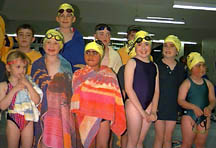
Click here for Thoughts about Swimming... by Sandy Webster, TransWeb volunteer
Click here for a description of the swimming event
as a whole.
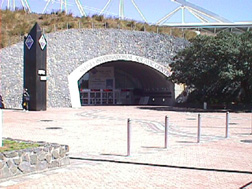
Entrance to the Aquatic Centre |
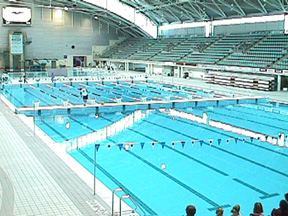 |
 |
 |
| There were five kids from Team Australia from the group Little Livers competing in swimming events. Little Livers is an organization in South Australia for kids who have liver transplants or liver disease. They are pictured at right: Chris Sweeney (10), William Piip (9), Ruth Weldon (12), Rebecca Edmiston (11), and Owen Cannard (15). Hear Their Cheer Here! | 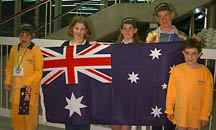 |

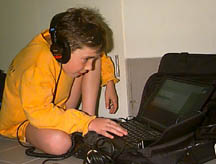 |
Young Chris Sweeney, with mum Jane, prepares for his swimming event
in the practice pool. He won the gold medal in the 25M breaststroke
for Team Australia.
Chris had a liver transplant when he was only eight months old. Click here to hear his impressions of the XI World Transplant games. Chris was kind enough to assist with the computer audio editing of his own interview. What a guy! |
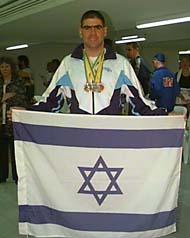 |
Moshe "Momo" Givoni brought honor to Team Israel by winning the gold medal in the100M freestyle, the silver in the 50M freestyle, and the bronze in the 50M butterfly. He is from Kefar Monash, Israel. Click here to hear an interview with him. | 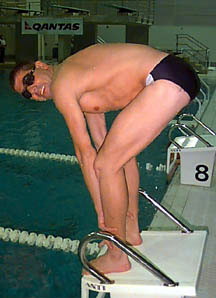 |
400M freestyle record held by Warwick Duncan (AUS) of 5.36 was broken by Michael Whitle with a time of 5.32.96.
Ray Velasco of the US set a record for his age group - he swam the 50M butterfly in 30.85.
Because of the event scheduling, Karen Couture of the US had to swim
the 400M freestyle, then go immediately to start the 50M butterfly.
USA Gold 50 M butterfly 44.0
"The best part about swimming is that I finished my race! I
remember thinking 'where's the wall??!'"
Swimming competition at the XI World Transplant Games began October 2 and continued throughout the day October 3,1997. This venue was hosted by the Sydney Aquatic Centre. Containing four pools (competitive swimming, diving, lap swimming, and large wading pools), several gymnasiums, an aerobics room, child care facilities, and food outlets as well as an outdoor picnic area, and volleyball courts, the Centre is truly magnificent. In its first year of operation (1994), the facility, which is open to the public, hosted over one million visitors.
The Centre will host the Olympic swimming and diving competition in the year 2000 and is designed to accomodate over 12,000 spectators. The vastness of the facility was evident: During the World Transplant Games simultaneous activities were taking place -- WTG swimming competition, WTG barbeque for 2000 individuals, public lap swimming, swim school, children and adults "playing" in the leisure pools, as well as those people in the weight and fitness rooms. The public lap pool is designed such that the bottom can be raised above water level to become a floor for a banquet area.
At the competitive pool, a World Transplant Games touching moment occurred
in the 6-7 year old 25m race. A number of competitors, barely as tall as
the diving blocks, lined up to face the challenge. One little girl, four
years old, in the near lane leapt into the pool, and turned right around
and grabbed for the edge, panicked and crying because the water was deeper
than she had thought it was going to be. She was pulled out of the pool
and put into her mother's waiting arms. Meanwhile the rest of the competitors
set out on what for them was a massive journey. While the winner took only
a few seconds to complete the 25m, with the other competitors right behind,
one competitor in lane 3 barely made it half way before she had to reach
for the lane marker. She made a number of attempts to keep going only to
swallow more water and grab for the marker again. Just as it appeared she
would not finish, a fellow teammate from Great Britain dived in to give
her a hand. The young girl was still trying and appeared about to give
up when her assistant arrived and swam beside her supporting her with one
arm. With the crowd, some cheering and some wiping away the tears welling
in their eyes, clapping their support, the little girl finished her race.
It summed up the whole reason we are here -- because someone lent us a
helping hand (in the form of an organ). As with many other competitions
examples like this have been suprisingly frequent though touching in their
own ways.
 |
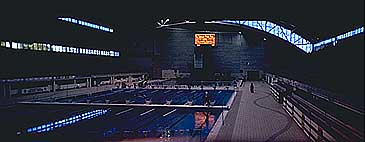 |
| Above: Swimming facilities at the Sydney International Aquatic Centre. Right: Recreational pool area at the Aquatic Centre. |
Venue: Sydney International
Aquatic Centre
|
Rules:
Swimming events will occur over the course of two days. There will be two sessions each day, with heats in the morning and finals later in the day or that evening (see Swimming Schedule -- Section D). Games Organizers have allowed for a break in competition on Friday to allow participants to compete in the Road Race. |